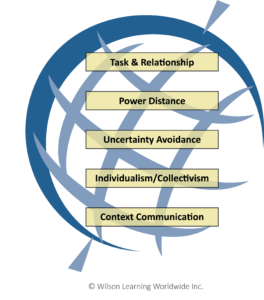Businesses big and small are participating in the global marketplace, and employees need not travel across the ocean to experience different cultures and ways of life. In order for business deals to run smoothly, it is becoming more important for every member of an organization to be able to interact effectively with people from other cultures. Many business opportunities are lost due to cultural misunderstandings. By equipping each employee with the appropriate knowledge, those deal-breaking, costly mistakes can be avoided.
 Global Effectiveness™ is based on working within the five cultural dimensions. This program will teach participants what types of behaviors to expect from certain cultures and how to prepare themselves for business interactions. Also, as participants learn about each of the five dimensions, they will understand stereotypes differently and will be able to make business interactions run more smoothly.
Global Effectiveness™ is based on working within the five cultural dimensions. This program will teach participants what types of behaviors to expect from certain cultures and how to prepare themselves for business interactions. Also, as participants learn about each of the five dimensions, they will understand stereotypes differently and will be able to make business interactions run more smoothly.
Program Outcomes
By implementing Global Effectiveness, each participant will become more interculturally savvy and thus more effective at conducting business across cultures. While many business deals dissolve from lack of understanding across cultures, this program gives participants a greater depth of knowledge to prevent such misunderstandings and complete business efficiently and effectively. Global Effectiveness turns cultural differences from an unknown liability into an asset.
Learning Approach
Wilson Learning believes that learning must be transferred to day-to-day work practices. To achieve this, Global Effectiveness includes components and activities that enhance Participant Readiness, Learning Transfer, and Organizational Alignment.
Participant Readiness prepares participants and managers for the overall learning experience:
- Pre-workshop communication
Learning Transfer design embeds practice and use of new skills. The learning can be flexibly delivered as a:
- Two-day face-to-face, application-oriented workshop
All can be delivered in modular format over non-consecutive days to allow application between sessions. This program can be taught by a Wilson Learning facilitator or by an organization’s own leader-trained in-house professional.
Organizational Alignment ensures the organization supports the use of the new skills:
- Post-learning reinforcement activities available for both the manager and participant
As a result, participants will continue to apply the skills and tools learned long after the learning event is completed. For a deeper background on social interactions, it may be beneficial for participants to attend the Building Relationship VersatilityTM course prior to attending Global Effectiveness.
Enabling Improved Performance
Global Effectiveness includes various performance application, reinforcement, and support tools, such as job aid cars and electronic reinforcement tools. These tools ensure that participants can hone newly acquired skills and behaviors upon returning to work. Involving managers early on and training them to coach to global effectiveness is also important for successful program implementation.
To discover how we ensure learning is reinforced and applied for improved performance, read more about our Learning Journeys.
Evaluation
Wilson Learning will partner with your organization to measure the initial behavioral changes and business results. We will work with you to set up evaluation systems that help improve outcomes and sustain the momentum of your implementation. Other research options are also available, such as a web-based survey of participants to identify the degree of change in key skills and document the differences this change makes.
To learn more about measuring the impact of learning, visit Measurement.

